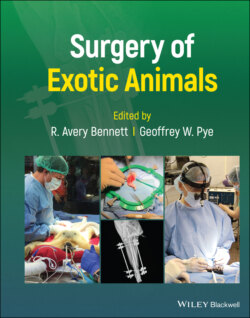Читать книгу Surgery of Exotic Animals - Группа авторов - Страница 95
Limulus
ОглавлениеLimulus polyphemus, the American horseshoe crab, is actually not a crab at all but a member of the Class Merostomata in the Phylum Chelicerata. Horseshoe crabs are more closely related to arachnids than crustaceans. Limulus is a very important animal for biomedical research, is used as bait and fertilizer, and is an important display and “touch tank” animal in public aquaria (Smith and Berkson 2005; Smith 2012). The anatomy and physiology of these animals have been thoroughly researched, and they are easy to handle and work with. Investigators examining vision and communication of the numerous ommatidia in the Limulus lateral eye were awarded the Nobel Prize for medicine or physiology in 1967 (Hartline and Ratliff 1958).
Trauma to the exoskeleton can be stabilized using epoxy. In the case of a fractured carapace, prepare the exoskeletal area where the epoxy will be affixed with an abrasive material like sandpaper. Manually reduce the fracture and stabilize it with the epoxy using digital pressure (Figure 4.9). The epoxy braces can be left in place as long as needed, but healing should occur within three to four months (Smith 2012).
Figure 4.9 These images illustrate fracture repair of a horseshoe crab (Limulus polyphemus) prosoma caused by a fall from a raised, shallow tank. (a) The fracture is located on the animal's right side and extends from an area rostral and medial to the compound eye caudally through the arthrodial ligament. (b) A sandpaper wheel is used to freshen areas of the prosoma for better epoxy adherence. (c) The fracture was manually reduced and stabilized, while a suite of four epoxy bridges were placed. (d) The animal responded well to the procedure and can be seen in its tank several weeks later.
Healing is initiated by amoebocytes, which initially form a clot, and progresses to scab formation and tissue healing. There are several kinds of cells involved in the process (Bursey 1977; Clare et al. 1990). Pluripotent cells called plasmatocytes appear to be responsible for the regeneration of tissues, like telsons, in very young animals (Clare et al. 1990).
Krasner et al. examined various suture materials (nylon, polyglecaprone, polydioxanone, polyglycolic acid, and silk) in the telson ligament of horseshoe crabs and found that monofilament nylon produced the least amount of tissue reaction, but none of the materials were superior with regards to holding, and none of the wounds dehisced.
